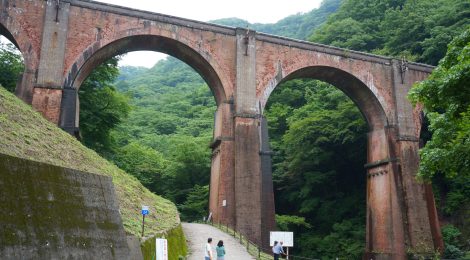
Usui 3rd Bridge
A bridge to a bygone era, now a nature trail
Built in 1892, the Usui 3rd Bridge functioned as a railway passage through the Usui Pass between Yokokawa in Gunma and Karuizawa in Nagano until services stopped in 1963. The nickname of this bridge is Meganebashi because the arches resemble spectacles (megane in Japanese).
Quick Facts
In 1993, it was designated a National Important Cultural Asset
It is the largest arched brick bridge in japan
The Usui 3rd Bridge is a remarkable structure that holds historical significance in Japan. Built in 1892, it served as a railway passage through the Usui Pass, connecting the towns of Yokokawa in Gunma and Karuizawa in Nagano. The bridge played a vital role in facilitating transportation and trade between the two regions during the Meiji era.
One of the most fascinating aspects of the Usui 3rd Bridge is its architectural design. Upon first glance, it may appear almost European in style, with its elegant arches and the use of red bricks. This unique blend of East meets West engineering is a testament to the collaboration between Japanese and British engineers during the early Meiji era. Under the guidance of British engineer Charles Assheton Whately Pownall, the bridge was constructed using advanced techniques and materials, making it a pioneering feat of engineering for its time.
The Usui 3rd Bridge holds the distinction of being the largest arched brick bridge in Japan. Its grandeur and impressive size make it a remarkable landmark that attracts visitors from near and far. The bridge’s nickname, Meganebashi, which translates to “spectacles bridge” in English, is derived from the distinctive shape of its arches, which resemble a pair of spectacles when viewed from a distance.
In recognition of its historical and architectural significance, the Usui 3rd Bridge was designated a National Important Cultural Asset in 1993. This prestigious designation highlights the bridge’s importance in preserving Japan’s cultural heritage and serves as a testament to its enduring value.
While the Usui 3rd Bridge no longer serves as a railway passage, it has found new life as a nature trail. In 2001, a six-kilometer trail was created along the disused railway lines, offering visitors a unique opportunity to explore the bridge and its surrounding natural beauty. Named Apt Road, this nature trail provides a scenic and peaceful route for hikers and nature enthusiasts to appreciate the bridge’s historical significance while enjoying the tranquil beauty of the Usui Pass.
Walking along Apt Road, visitors can immerse themselves in the rich history of the Usui 3rd Bridge. As they traverse the path, they can imagine the hustle and bustle of trains passing through the bridge, carrying passengers and goods between Gunma and Nagano. The trail offers a glimpse into the challenges faced by engineers and workers who constructed the bridge, as well as the stunning landscapes that inspired them.
The Usui Pass, where the bridge is located, is known for its breathtaking scenery. Surrounded by lush greenery and majestic mountains, the area offers a peaceful retreat from the hustle and bustle of city life. As visitors walk along the trail, they can admire the natural beauty of the Usui Pass and appreciate the harmony between man-made structures and the surrounding environment.
To reach the Usui 3rd Bridge, the easiest way is by car due to limited public transportation options. Travelers can follow the Nakasendo Highway towards Karuizawa and will spot the bridge shortly after passing Lake Usui. Alternatively, they can take the Shinetsu Line from Takasaki to Yokokawa Station and embark on a one-hour and thirty-minute walk to reach the bridge. Whichever route they choose, visitors are rewarded with a captivating journey that culminates in the discovery of a hidden gem.
The Usui 3rd Bridge stands as a testament to the ingenuity and craftsmanship of its creators. It serves as a reminder of Japan’s rich history and the significant role played by its engineers in shaping the nation’s infrastructure. Whether for its architectural beauty, historical significance, or natural surroundings, the bridge continues to captivate and inspire all those who visit.
Address And Maps Location:
Matsuida-machi Sakamoto Chinai, Annaka-shi, Gunma-ken
Subscribe, follow @idbcpr and idbackpacker.com